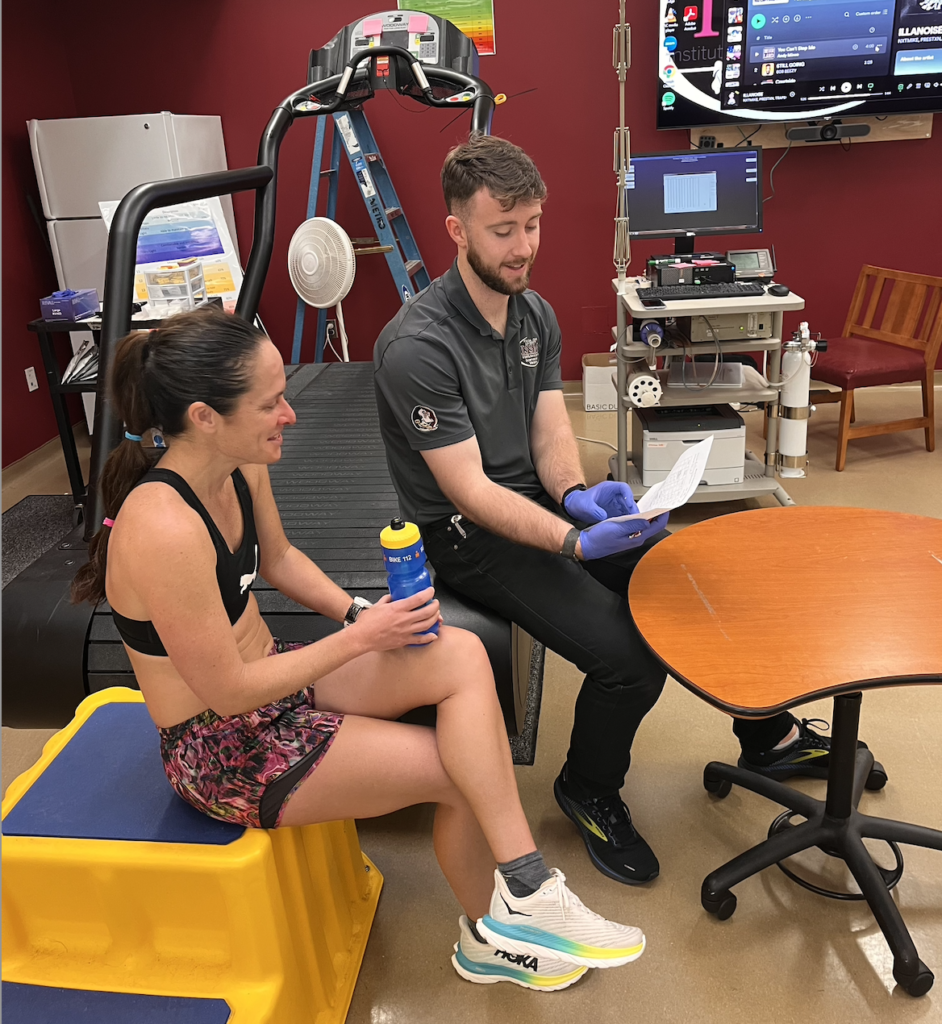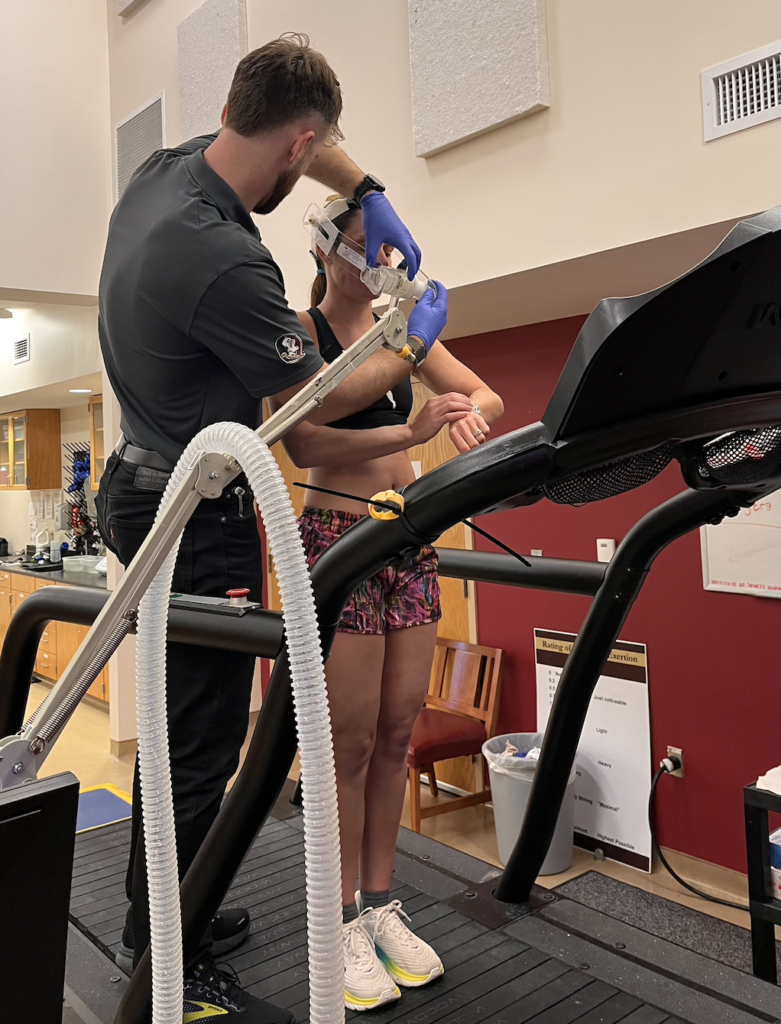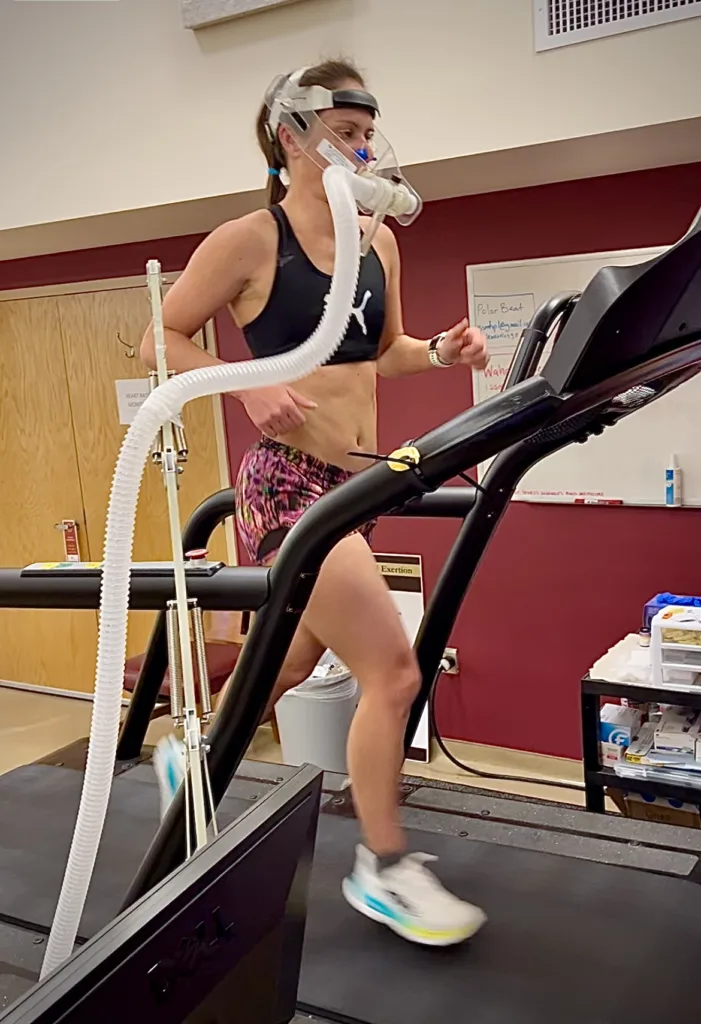
Last month, I had the opportunity to do performance testing at FSU’s Institute of Sport Sciences and Medicine. The tests included VO2 max, lactate threshold, resting metabolic rate, and body composition.
It’s a great way to see if my fitness has increased during the off season and to set some baseline values to help my coach target new training zones.
This was my first time doing performance testing in a lab, and there are three surprising insights I learned from VO2 max and lactate testing…

First up was a VO2 max test and lactate threshold test on the treadmill. It’s a graded exercise test, so every few minutes they increase the speed and incline until you can’t run any longer. Basically, it’s a test to exhaustion. Sounds fun, right!
What’s VO2 max?
VO2 max is the maximum amount of oxygen your body can utilize during intense exercise. The purpose of a VO2 max test is to determine the efficiency of your cardiovascular system. It’s also a key determiner of aerobic endurance. Theoretically, an athlete with a higher VO2 max should be able to sustain a higher level of intensity for a longer period of time before fatigue sets in.
I learned that my VO2 max places me in the 95% percentile of my age and gender, so it’s “superior.” Yay!
The first thing I was surprised to learn: In order to measure VO2 max, you have to wear a mask that fits over your mouth, which connects to a tube that you breathe through. However, it’s important that no air escapes during the test, so you also have to wear a nose clip. I wasn’t prepared for this, and it takes some getting used to, especially if you’re an athlete who breathes out of your nose and mouth while running.

What’s lactate threshold?
To understand lactate, you need to know about ATP. ATP (Adenosine Triphosphate) is the fuel that powers your body during exercise. Think of it like the gasoline that powers a car.
When you’re running or riding your bike at an easy pace, your body uses aerobic (with oxygen) metabolism to produce ATP. But as the intensity of exercise increases, your muscles can’t supply enough oxygen to keep up with the demand for more ATP, so the body shifts to anaerobic (without oxygen) metabolism. It works great, but it also creates a byproduct called lactate. When lactate accumulates in the muscles and bloodstream, you can only keep going for a certain period of time before you have to either slow down or stop.
When lactate production exceeds the body’s ability to remove it, that’s referred to as lactate threshold or anaerobic threshold.
The second thing I was surprised to learn: Not only do they gradually increase the speed at which you’re running on the treadmill, they also increase the grade, or incline. Before the test, I assumed I would get up to, and likely surpass, my 5K pace, because it was a test to exhaustion. But I never got close! I tapped out while running at my 10K pace, because I was running up a 7% grade!
All this to say that the pace you run during performance testing doesn’t matter. They’re only concerned about your heart rate, and they want to get you up to that max point in a gradual, but efficient manner. The entire test took about 23 minutes.
My friend Kieran at FSU ISSM explained something interesting. He said that when they look at athletes, they often see a diagonal graph for VO2 max and more of a steep incline in the lactate threshold graph. When the two points on the graph meet closely, it’s a good sign of excellent fitness and performance capability. This is because your body is able to take in the max amount of oxygen, while your muscles are still able to clear out lactate.

The third thing I was surprised to learn: You have two lactate values- lactate threshold 1 (LT1)- the lowest intensity at which there’s a sustained increase in lactate, and lactate threshold 2 (LT2)- the max lactate state. My coach can use both these values to help set my training zones. By exercising at, or slightly above, lactate threshold, I can improve my ability to tolerate higher levels of lactate and become more resistant to fatigue, which will improve endurance performance.

On a different day, I did the fastest tests (no eating ahead of time) to determine my resting metabolic rate and body composition. The test to determine resting metabolic rate was super relaxing compared to lactate threshold! It involves lying down and staying relaxed, while wearing an astronaut-type hood over your head to measure your oxygen level. It took about 30 minutes. I learned that in order to maintain my current weight, I need to eat 2,500-2,750 calories a day.
The final test was for body composition, and this was the quickest of them all. It only took 60 seconds. While wearing tight fitting clothing and a swim cap, you sit inside a BOD POD- a device that looks like a large egg with a window so you can look out. It determined your percentage of body fat versus muscle. Apparently I’m in a typical range for female athletes. Yay!
Overall, this was a really cool experience. If you have the opportunity to do this kind of science testing, it’s something I’d highly recommend. It’s fascinating to learn how the body works, and you can use the data to further dial in your training zones to improve your triathlon performance.


